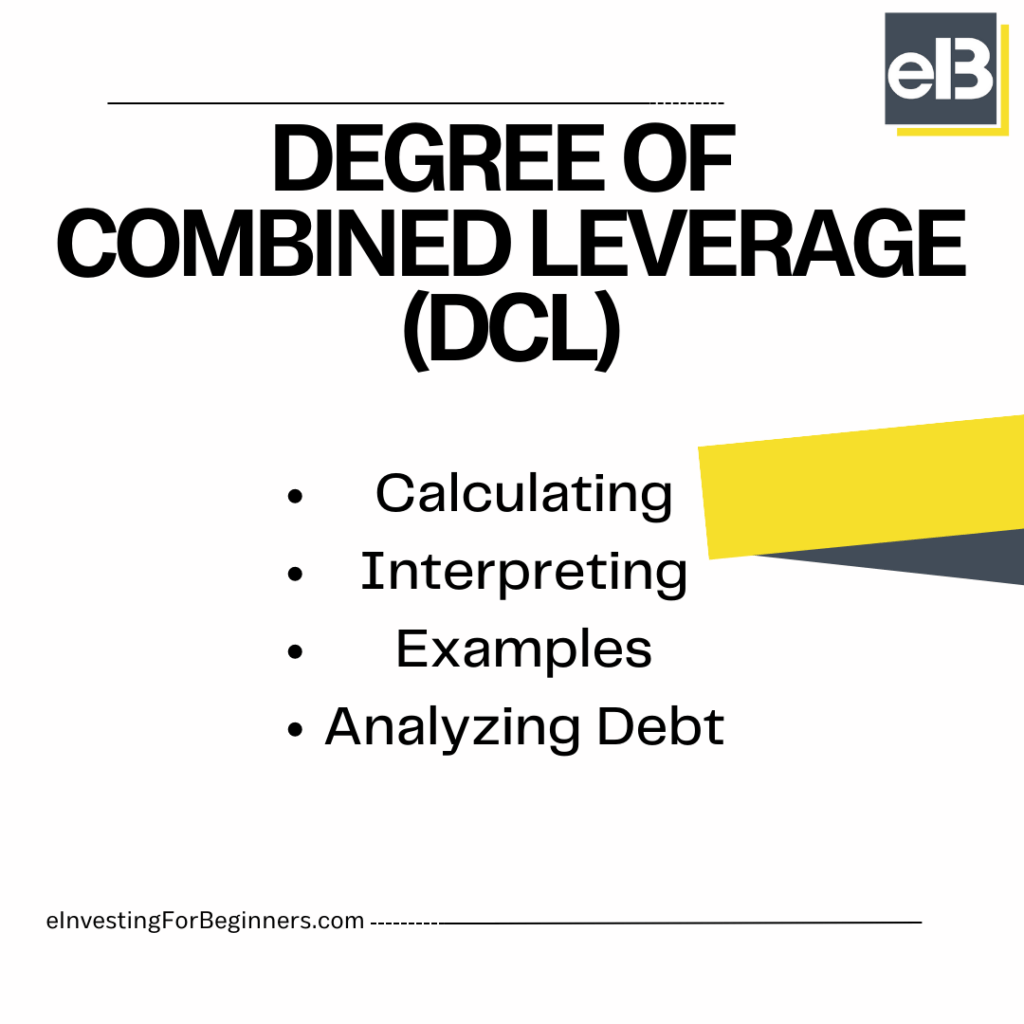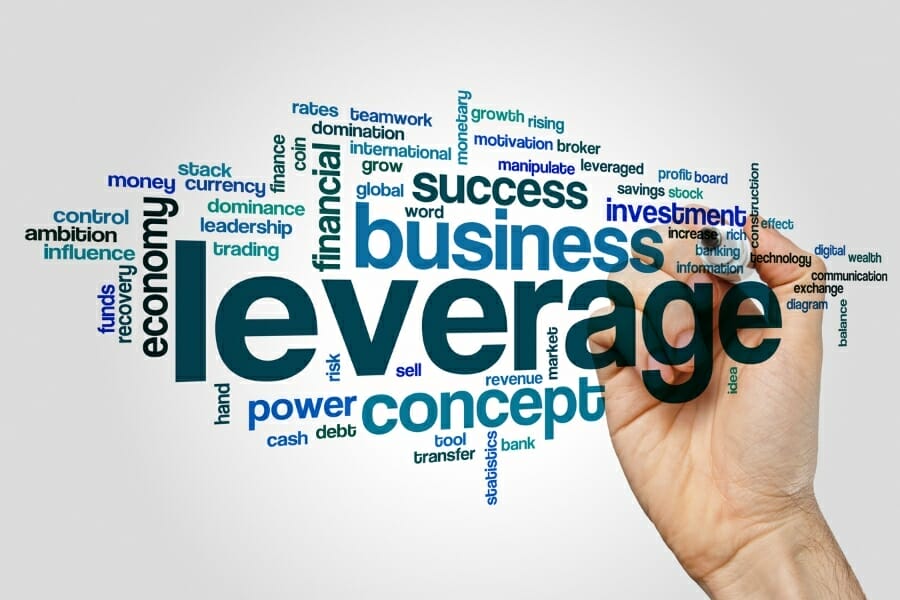The degree of combined leverage (DCL) is a valuable tool for a company to determine its risk level on both operating (DOL) and financial leverage (DFL). In addition, it can be manipulated to determine the effects of leverage on a company’s sales. This post will cover calculating this value and how to use it to analyze a company’s financials.
Click to jump to a section:
- Calculating DCL
- Interpreting DCL
- Example Low DCL Calculation
- Example High DCL Calculation
- How Do Companies Use DCL?
- What Does a Low DCL Indicate?
- What Does a High DCL Indicate?
- Is High Leverage (Debt) Good or Bad?

Calculating DCL
DCL is an indicator of how leveraged a company is, in addition to how strongly shifts in its sales affect its EPS. DCL is intended to find the total leverage of a company, taking into account different forms of available leverage.
A company utilizing leverage is much like an investor using leverage. For an individual, this is known as margin investing. This is where an investor takes out a margin, a loan, from their brokerage to invest with more capital than they have. This amplifies their ability to make money, in addition to their ability to lose it.
Calculating DCL is a simple process. It can be found using only the company’s percent change in earnings per share (EPS) and its percent change in sales volume over the same period. See the following formula:

- DCL = Degree of Combined Leverage
- EPS = Earnings per Share
- DOL = Degree of Operating Leverage
- DFL = Degree of Financial Leverage
A change in sales revenue can be found by finding the percent difference in the number of units sold through a period, assuming unit cost and production cost stay the same. If a company sells items for $12 per unit, the total costs to produce a unit is $2, and it sells 100 of them, its revenue is $1,000. If it sells 110 units next quarter, that is a 10% change in sales revenue.
Sales revenue is affected by how much the units sell for and what it costs to produce them. The rising cost of raw materials and labor can decrease sales revenue, even if the total number of sales is steady.
Earnings per share are the earnings of a company that an investor owns for every share held. For example, an EPS of $5 means that every share of that company owns $5 worth of the company’s earnings.
EPS can be easily calculated by dividing a company’s earnings by the number of outstanding shares.

The degree of operating leverage describes the relation between a company’s fixed costs and variable costs. In addition, it measures the impact a given change in sales has on a company’s operating income. A high DOL indicates that increasing sales has a significant effect on operating income.

The degree of financial leverage aids in understanding the amount of debt a company uses to finance its operations. In practice, this is a ratio between the company’s EPS and fluctuations in operating income. This ratio describes the sensitivity of a company’s EPS to fluctuations in operating income. A high DFL indicates that operating income has a significant impact on EPS.

Interpreting DCL
Once you have a company’s DCL, you have an indication of how a change in sales revenue affects a change in earnings per share. A DCL of 1 indicates that every 1% change in sales results in a 1% change in EPS.
A DCL greater than one indicates that a change in sales will have a more significant effect on its earnings per share.
For an investor, EPS is vital. After all, when you invest, you are looking to share in the success of a company. There is no more direct form of this than sharing in a company’s earnings.
When looking to invest in a company, DCL can be used to predict how its EPS will move in the future. If you see a high DCL and predict increased sales in the future due to market demand or other factors, it may be a good time to buy. Any increase in future sales will have an even more significant impact on the company’s EPS.
DCL is also a helpful tool in determining a company’s level of business risk. A high DCL puts a company at risk of a drop in sales, tanking its EPS. A low DCL can indicate difficulty in using leverage to produce higher EPS.
The caveat is that DCL utilizes past performance to predict future performance. As with any investing method, there is no way to predict the future. The best we can do is analyze the past and project it to the future.
A high DCL is neither good nor bad on its own. A high DCL during a downturn means that EPS will plummet as sales fall, whereas a high DCL during a boom means EPS will shoot up as sales increase.
Example Low DCL Calculation
Let’s take Apple as an example. This isn’t a company that uses much debt to function. They have a ton of cash ready to go, so they don’t take out many loans.
In addition, much of its success is based on its software through things like software updates and subscriptions. To succeed in software, you don’t need nearly as much capital to fund things like raw materials.
Finally, though Apple has some physical stores, most of its business is done online. This reduces the need to fund a bunch of brick-and-mortar locations.
Their EPS increased from $5.61 in 2021 to $6.11 in 2022, an 8.91% increase.
Over the same period, their sales went from $365.8 billion $394.3 billion, a 7.79% increase.
In this example, from 2021 to 2022, Apple’s degree of combined leverage was 1.14. With a DCL of 1.14, every 1% change in sales results in a 1.14% change in EPS.
Example High DCL Calculation
Next, let’s take a look at Lowe’s. Lowe’s is a company that relies entirely on its ability to obtain and maintain physical inventory. Funding this inventory, especially during downturns, requires a lot of capital and cash flow. This often requires companies like Lowe’s to take on debt to cover expenses.
Plus, most of Lowe’s business is done in person. They cater to an older crowd that works with their hands, who are less likely to buy items online. Building all of the necessary locations, covering maintenance, and paying in-person staff are huge expenses.
Their EPS increased from $7.75 in 2021 to $12.04 in 2022, a 55% increase.
In the same period, their sales went from $89,597 to $96,250, a 7.4% increase.
This ratio works out to a DCL of 7.43! A 1% change in sales would result in a 7.43% change in EPS.
This falls in line with the amount of debt that Lowe’s is known to use.
If Lowe’s can take advantage of rebuilt supply chains post-pandemic, it could boost its EPS significantly with increased sales. Impressive for a company that struggled during high raw material costs.

How Do Companies Use DCL?
DCL isn’t just used by investors. The company itself also uses it to analyze its performance, financial management, and future outlook.
A high DCL may be an indicator that a company is overleveraged. An overleveraged company is taking on too much risk for its level of earnings.
On the contrary, a low DCL may indicate that they could take on more leverage to amplify earnings. If a company is doing well in increasing its sales but has a low DCL, it won’t see those sales result in the increase in EPS otherwise possible.
Companies go through cycles. For example, retail sees a boom before the holidays due to shopping for Christmas, and fixed costs stay consistent. This is a predictable, expected increase in sales during a specific time of year.
If a company wants to take advantage of this predictable boom, it needs a high-enough DCL. A high DCL will allow it to inflate its EPS alongside its sales. It needs to be careful, though, not to be highly leveraged when its sales drop. Otherwise, this will negate their gains before the holidays.
What Does a Low DCL Indicate?
If a company has a low DCL, such as around 1, the company has less risk but also less opportunity.
Having low DCL means that the company has less leverage, so it is at less risk of fluctuating wildly with changes in sales. For an investor looking for a safe bet, this may be ideal.
However, a low DCL also means the company can’t take advantage of rising sales as much. It isn’t ideal if every 1% shift in sales only results in a 1% shift in earnings.
What Does a High DCL Indicate?
A company with a high DCL, over 4, for example, is taking on a lot of risk to take advantage of increases in sales.
A high DCL will amplify any sales changes to even greater EPS changes. A DCL of 4 means that for every 1% increase in sales revenue, EPS jumps by 4%. If a company is confident in its future performance, that can be a game changer.
For an investor, if you are confident in a company’s future, a high DCL is great. If you believe that Amazon will successfully take over the cloud industry, a high DCL means you feel the amplified EPS as its sales increase.

Is High Leverage (Debt) Good or Bad?
The worst answer you can get, it depends. For some sectors and businesses, debt is a valuable tool that can help their business reach heights not otherwise possible. However, if not handled properly, it can lead to enormous downsides for the business and its shareholders.
How a business handles debt is affected by its business model, cash flows, and capital structure.
Let’s cover arguments from both sides.
The Argument for Debt
A company having high debt can be a helpful tool. For one, a loan does not provide an ownership stake, so it doesn’t dilute the owners’ position. As an investor, this is great. It would be horrible for your position to be diluted because the company took on debt.
Second, debt is a quick, accessible way to gain capital for growth. A company needs a lot of capital to grow. Debt can be quickly accessed without waiting for investors to notice them or to make the cash themselves. Primarily if a company focuses on products reliant on raw materials and in-person sales, debt may be a necessity.
All in all, a company in the growing stages can use debt the best. The beginning of a company’s trajectory is when it sees the highest growth rate. That means it is also the perfect time to amplify the effects of that growth and its ability to grow by taking on debt. Then, once it has sufficiently developed to fund itself, it can repay the debt like it never even happened.
The Argument Against Debt
Debt may be useful in the right circumstances, but it can also be devastating in the wrong situation. For example, a company can take on so much debt that all of its returns go toward paying off its debt. This makes it difficult for a company to generate a cash surplus. A cash surplus is necessary for withstanding market downturns and funding significant investments.
In addition, high debt is dangerous if the company becomes insolvent. This is when the company cannot afford its debts when they come due. This usually occurs when the company fails to generate the returns it expected from its debt.
Common stockholders are the last to get paid back if a company becomes insolvent. That’s scary when you consider that you could lose all your invested money if a high-debt company fails to pay back its debts.
A company may not even need to take on much debt if its business model relies more heavily on online sales. For example, the tech sector doesn’t need to take on much debt. Companies in this sector rely far more on continuous sales like subscriptions than expensive one-time sales.

Evan Raidt
Evan is a personal finance blogger passionate about bringing beginner investors into the stock market world.
Related posts:
- What is a Good PEG Ratio? Updated: 4/6/2023 The PEG ratio was one popularized by the famed fund manager Peter Lynch, who went on to post one of the best mutual...
- How the Piotroski Score Identifies Strong Businesses in the Stock Market Updated 4/28/2023 One of the biggest challenges when determining whether or not to invest in a company is determining each company’s financial strength. Enter the...
- The Price to Sales (P/S) Ratio Formula Explained Price to Sales (“P/S”) is one of the more common and simple relative valuation ratios used to generally compare how expensive or cheap a stock...
- 4 Types of Company Growth Rates and How to Calculate Them Investors demand growth from companies. Wall Street loves growth. But how is company growth defined exactly? In this post we’ll examine 4 separate types of...
